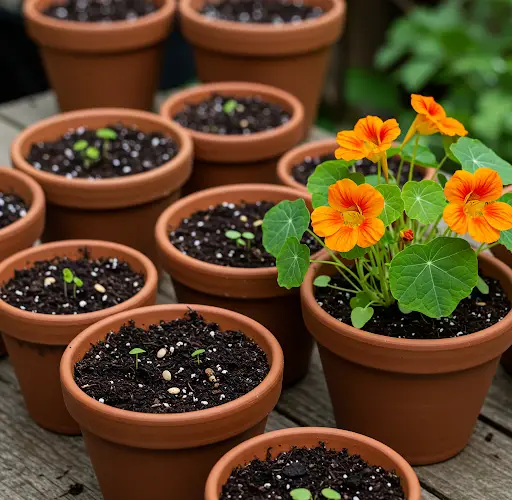Nasturtiums (Tropaeolum majus and Tropaeolum minus) are vibrant, fast-growing annuals that thrive in containers, making them ideal for small gardens, patios, and balconies. Their cheerful blooms come in shades of red, orange, and yellow, and both the flowers and leaves are edible, adding a peppery zest to salads. Beyond their aesthetic and culinary appeal, nasturtiums serve as excellent companion plants, attracting beneficial insects and deterring pests.
This comprehensive guide will walk you through the steps to successfully grow nasturtiums from seed in pots, ensuring a lush and colorful display throughout the growing season.
1. Selecting the Right Nasturtium Variety
Nasturtiums come in two primary growth habits: bush (compact) and trailing (vining).
-
Bush Varieties: These compact plants are perfect for containers and small spaces. Examples include ‘Alaska Mix’ and ‘Jewel Mix’.
-
Trailing Varieties: Ideal for hanging baskets or allowing to cascade over container edges. Varieties like ‘Empress of India’ and ‘Yeti’ offer stunning trailing displays.
Choose a variety that suits your container size and aesthetic preferences.
2. Preparing the Container
Select a pot with adequate drainage holes to prevent waterlogging. While nasturtiums aren’t overly fussy about soil, they prefer well-draining, moderately fertile soil. Overly rich soil can lead to excessive foliage growth at the expense of flowers.
-
Soil Mix: Use a general-purpose potting mix. Avoid adding extra fertilizer, as this can reduce blooming.
-
Pot Size: For bush varieties, a 10-12 inch (25-30 cm) pot is sufficient. Trailing types may require larger containers or hanging baskets to accommodate their growth.
3. Sowing the Seeds
Nasturtium seeds are large and easy to handle, making them suitable for gardeners of all experience levels.
-
Soaking Seeds: To expedite germination, soak seeds in warm water for 12-24 hours before planting.
-
Planting Depth: Sow seeds about ½ inch (1.25 cm) deep.
-
Spacing: Plant seeds 10-12 inches (25-30 cm) apart to allow ample room for growth.
-
Timing: Sow seeds directly into the container after the last frost date in your area. Nasturtiums do not transplant well due to their sensitive roots.
4. Germination and Early Growth
With proper care, nasturtium seeds typically germinate within 10-14 days.
-
Light: Place the container in a location that receives full sun (6-8 hours daily). In hotter climates, some afternoon shade can help prevent scorching.
-
Watering: Keep the soil consistently moist but not waterlogged. Overwatering can lead to root rot.
-
Thinning: Once seedlings have developed their first set of true leaves, thin them to maintain proper spacing, allowing the strongest plants to thrive.
5. Ongoing Care and Maintenance
Nasturtiums are low-maintenance plants, but a few care tips can enhance their growth and flowering.
-
Watering: Water regularly, especially during dry spells. Ensure the soil remains moist but not soggy.
-
Fertilization: Avoid excessive fertilization. Too much nitrogen can promote leaf growth over flowers.
-
Pruning: Regularly deadhead spent flowers to encourage continuous blooming. If plants become leggy, trim them back to promote bushier growth.
6. Pest Control and Companion Planting
Nasturtiums are known for their pest-repelling properties.
-
Trap Crops: They can attract aphids and other pests away from more vulnerable plants, acting as a natural pest control method.
-
Beneficial Insects: Their bright flowers attract pollinators like bees and butterflies, enhancing the health of your garden ecosystem.
7. Harvesting and Edibility
One of the delightful aspects of nasturtiums is their edibility.
-
Leaves and Flowers: Both are edible and have a peppery flavor, similar to arugula. They make a colorful addition to salads and garnishes
-
Seed Pods: Young, green seed pods can be harvested and pickled, often referred to as “poor man’s capers.”
8. Saving Seeds for Future Planting
Nasturtiums readily produce seeds that can be collected for future planting.
-
Collection: Allow seed pods to mature and dry on the plant. Once they turn brown and fall off, collect them.
-
Storage: Store seeds in a cool, dry place in a paper envelope or container. Properly stored seeds remain viable for up to three years.
Conclusion
Growing nasturtiums from seed in pots is a rewarding endeavor that adds beauty, flavor, and ecological benefits to your garden space. With minimal care, these vibrant plants will flourish, providing continuous blooms and edible delights throughout the growing season.



